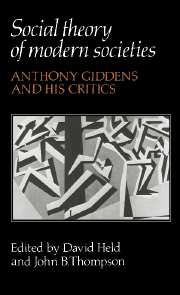Book contents
- Frontmatter
- Contents
- List of contributors
- List of abbreviations
- Editors' introduction
- 1 Social theory as critique
- 2 Hermeneutics and modern social theory
- 3 The theory of structuration
- 4 Models of historical trajectory: an assessment of Giddens's critique of Marxism
- 5 Capitalism, nation-states and surveillance
- 6 War and the nation-state in social theory
- 7 Only half the story: some blinkering effects of ‘malestream’ sociology
- 8 Citizenship and autonomy
- 9 Presences and absences: time–space relations and structuration theory
- 10 Space, urbanism and the created environment
- 11 On the (ir)relevance of structuration theory to empirical research
- 12 A reply to my critics
- Select bibliography
- Index
3 - The theory of structuration
Published online by Cambridge University Press: 24 November 2009
- Frontmatter
- Contents
- List of contributors
- List of abbreviations
- Editors' introduction
- 1 Social theory as critique
- 2 Hermeneutics and modern social theory
- 3 The theory of structuration
- 4 Models of historical trajectory: an assessment of Giddens's critique of Marxism
- 5 Capitalism, nation-states and surveillance
- 6 War and the nation-state in social theory
- 7 Only half the story: some blinkering effects of ‘malestream’ sociology
- 8 Citizenship and autonomy
- 9 Presences and absences: time–space relations and structuration theory
- 10 Space, urbanism and the created environment
- 11 On the (ir)relevance of structuration theory to empirical research
- 12 A reply to my critics
- Select bibliography
- Index
Summary
The problem of the relation between the individual and society, or between action and social structure, lies at the heart of social theory and the philosophy of social science. In the writings of most major theorists, from Marx, Weber and Durkheim to a variety of contemporary authors, this problem is raised and allegedly resolved in one way or another. Such resolutions generally amount to the accentuation of one term at the expense of the other: either social structure is taken as the principal object of analysis and the agent is effectively eclipsed, as in the Marxism of Althusser, or individuals are regarded as the only constituents of the social world and their actions and reactions, their reasons, motives and beliefs, are the sole ingredients of social explanation. In both cases the problem is not so much resolved as dissolved, that is, disposed of beneath a philosophical and methodological platform that is already located in one of the camps. Few questions in social theory remain as refractory to cogent analysis as the question of how, and in precisely what ways, the action of individual agents is related to the structural features of the societies of which they are part.
In recent years several authors have confronted directly the problem of the relation between action and social structure and have attempted to deal with it in a constructive and systematic way. Essential to these attempts is the shift from a static to a dynamic perspective, from a theory of structure to a theory of structuration.
- Type
- Chapter
- Information
- Social Theory of Modern SocietiesAnthony Giddens and his Critics, pp. 56 - 76Publisher: Cambridge University PressPrint publication year: 1989
- 78
- Cited by



